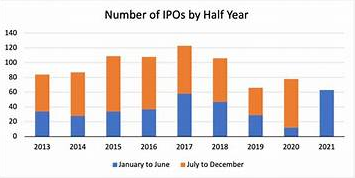Table of Contents

Imagine you run a small shop, and your product is flying off the shelves. Demand is high, but your funds are low, so you can’t keep up. To meet the demand, you need extra cash. So, you look for someone to fund you, but they want a share of your profits in return. You agree because your top priority is to get that cash to grow your business. This scenario is pretty much what an IPO (initial public offering) is all about!

What Is an IPO?
An IPO (initial public offering) is when a company decides to go public by offering its shares to the public for the first time. Just like your shop needed funds to expand, companies use IPOs to raise capital for growth, development, and other needs.
Why Do Companies Go for IPOs?
- Raise Capital: Just like you needed money to buy more stock, companies need cash for various purposes like expanding operations, researching new products, or paying off debt.
- Public Awareness: An IPO can generate buzz and make more people aware of the company and its products, helping to increase its market share.
- Exit Strategy for Venture Capitalists: Venture capitalists who invested early on can sell their shares and make a profit when the company goes public.
- Business Growth: An IPO can fuel a company’s expansion plans, much like how additional funds help you grow your shop.

Benefits of Investing in IPOs
When you invest in an IPO, you’re essentially buying a piece of a growing company. Here’s why people might invest:
- Listing Gains: When an IPO launches, there’s often a lot of excitement. If demand is high, the stock price can jump on the first day of trading. This is known as “listing gains.”
- Long-Term Investment: If you believe in the company’s future and growth potential, buying shares during the IPO can be a great investment for the long term.
How IPOs Work

- Price and Lot Size: The company sets a price range for the shares and a lot size (the minimum number of shares you can buy). If there’s high demand, the stock might start trading at a higher price.
- Application Process: To invest, you apply for shares at the IPO price. If there are more applications than shares available, only some investors get to buy shares.
- Example of Success: Take the IPO of DMART. In March 2017, DMART shares were priced between Rs 295 and Rs 299. Those who bought shares at that price saw their investment grow tenfold in just four years!

What to Check Before Investing in an IPO
Before you jump in, consider these factors:
- Company Financials: Check the company’s balance sheet and profit & loss statements.
- Growth Record: Look at the company’s sales growth over the last five years.
- P/E Ratio: Compare the company’s Price-to-Earnings ratio with the industry average.
- Promoter’s Record: Who’s behind the company? Have they pledged their shares as collateral?
- Free Cash Flow: What’s the company’s cash situation?
- PEG Ratio: The Price/Earnings to Growth ratio can give you insights into valuation.
- Future Plans: What does the company plan to do with the money raised from the IPO?
How to Apply for an IPO
- Open a Demat and Trading Account: You’ll need these accounts to store and trade shares. Many brokerage firms offer these services, sometimes with zero brokerage fees.
- Apply for the IPO: During the application period, you can apply for one or multiple lots of shares.
Biggest Indian IPOs
| Company | Amount Raised | Date |
|---|---|---|
| LIC (Life Insurance Corporation of India) | ₹21,000 crore | May 2022 |
| Paytm (One97 Communications) | ₹18,300 crore | November 2021 |
| Coal India | ₹15,200 crore | October 2010 |
| Reliance Power | ₹11,700 crore | January 2008 |
| NTPC (National Thermal Power Corporation) | ₹10,000 crore | November 2004 |
| SBI Life Insurance | ₹8,400 crore | September 2017 |
| Adani Green Energy | ₹6,000 crore | July 2021 |
| Zomato | ₹9,375 crore | July 2021 |
| Bharti Airtel | ₹8,000 crore | October 2002 |
| HDFC Life Insurance | ₹8,000 crore | November 2017 |
So, just like your small shop needed funds to grow and meet the increasing demand, companies use IPOs to raise capital for their expansion and development. And as an investor, you get a chance to buy shares and potentially benefit from the company’s success.
I hope this helps you get a handle on IPOs and how they work! 🚀📈
FAQs
1. What is IPO in simple words?
An IPO, or Initial Public Offering, is when a private company offers its shares to the public for the first time. Think of it as a company opening its doors for public investment and trading on the stock market.
2. How do you explain an IPO?
An IPO is the process by which a private company becomes publicly traded by offering its shares to the public. It involves several steps, including regulatory approval, setting a share price, and listing on a stock exchange. This allows anyone to buy shares and own a part of the company.
3. Is it good to buy in IPO?
Buying in an IPO can be good if you believe in the company’s growth potential. Early investors can benefit from significant price appreciation. However, it also carries risks as the company’s future performance is uncertain. It’s crucial to do thorough research before investing.
4. Why do companies go IPO?
Companies go public to raise capital for expansion, pay off debt, or fund other business activities. An IPO also increases the company’s visibility and credibility, potentially attracting more customers and partners.
5. Who is eligible for IPO?
Eligibility for participating in an IPO varies by country and brokerage requirements. Generally, individual investors, institutional investors, and qualified buyers who meet certain criteria can apply for IPO shares. Retail investors often need to have a brokerage account.
6. Who can invest in IPO?
Both individual and institutional investors can invest in an IPO. Retail investors typically apply through their brokerage accounts, while institutional investors may participate through large investment firms.
7. How to earn money from IPO?
You can earn money from an IPO by buying shares at the offering price and selling them at a higher price once they start trading on the stock exchange. Some IPOs experience significant price jumps on their first trading day, providing opportunities for quick profits.
8. How to buy IPO?
To buy IPO shares, follow these steps:
- Open a brokerage account if you don’t have one.
- Research upcoming IPOs and choose the one you want to invest in.
- Submit an IPO application through your brokerage platform.
- If your application is approved, you’ll receive shares at the offering price.
9. What are the benefits of an IPO?
Benefits of an IPO include:
- Access to capital: Companies can raise substantial funds for growth and development.
- Increased visibility: Being publicly traded enhances the company’s profile and credibility.
- Liquidity for shareholders: Existing shareholders can sell their shares and realize gains.
- Potential for higher valuation: Public companies often receive higher valuations compared to private companies.

Latest episodes
Leave a Reply